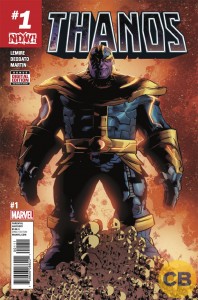 Thanos #1 — Writer: Jeff Lemire; Art: Mike Deodato; Colors: Frank Martin
Thanos #1 — Writer: Jeff Lemire; Art: Mike Deodato; Colors: Frank Martin
Doctor Strange #14 — Writer: Jason Aaron; Pencils: Chris Bachalo; Inks: Al Vey, John Livesay, Victor Olazaba, Tim Townsend and Wayne Faucher; Colors: Anronio Fabela with Java Tartaglia
Black Panther #8 — Writer: Ta-Nehisi Coates; Layouts: Chris Sprouse; Finishes: Karl Story with Walden Wong; Colors: Laura Martin
Of the Marvel books this week, the only first issue is a relaunch — but an effective one, as Thanos of Titan, one of the company’s premiere bad guys (and a key figure in their upcoming movies) gets another series, this one scripted by the always-interesting and always-dependable Jeff Lemire, and drawn by one of their top superhero artists, Mike Deodato. It’s not easy doing a book about a villain — you need compelling good guys to fight him, and you need to work around the whisper in the back of the readers’ minds that, inevitably, he’s going to win; otherwise, no more comic. Wisely, Lemire keeps his main character at a distance; we don’t know what’s going through his purple head, but we’re shown how formidable he is, and then we switch to his opponents: his son Thane, his brother Starfox, the Elder of the Universe called  Champion, and a mysterious woman. Add in one of those big-revelation last pages, and Thanos, which begins with an already-built-in audience, should prove viable for quite a while. Doctor Strange is another Marvel book that will no doubt benefit from its character’s movie stardom — but it’s been a great comic for awhile anyway, ever since its relaunch, with Aaron and Bachalo crafting a blend of humor, suspense and fantasy that’s seen an uprooting of the rules of magic, a vastly-depowered Sorcerer Supreme, and the return of a number of old enemies. This issue, the Doctor ends up in hell (or a hell…), courtesy of old adversary Satana, who wants to capture his soul as a concert attraction for new arrivals to her realm; we find out what “hell bacon” is, catch up on obscure demonic bad guy Master Pandemonium, and get to watch as Bachalo makes the Devil’s Daughter just as sinister and sexy as she should be (for an example, check out the issue’s cover, up there to the right…). This works both as a chapter in a longer arc and as a satisfying story in its own right, with a beginning, middle and conclusion, and just enough of what’s coming in the next installment to keep bringing us back for more: that’s a lot harder than it looks to do every month, but this team has been accomplishing it for over a year now, making it one of the company’s better-selling books even before Doc got himself a number-one hit film too. Black Panther‘s also got his own cinematic presence now, with a debut in this year’s Captain America: Civil War and his own film on the (relatively distant) horizon. Marvel took a chance in hiring a non-comics pro to helm his relaunch — but, considering that Coates is a
Champion, and a mysterious woman. Add in one of those big-revelation last pages, and Thanos, which begins with an already-built-in audience, should prove viable for quite a while. Doctor Strange is another Marvel book that will no doubt benefit from its character’s movie stardom — but it’s been a great comic for awhile anyway, ever since its relaunch, with Aaron and Bachalo crafting a blend of humor, suspense and fantasy that’s seen an uprooting of the rules of magic, a vastly-depowered Sorcerer Supreme, and the return of a number of old enemies. This issue, the Doctor ends up in hell (or a hell…), courtesy of old adversary Satana, who wants to capture his soul as a concert attraction for new arrivals to her realm; we find out what “hell bacon” is, catch up on obscure demonic bad guy Master Pandemonium, and get to watch as Bachalo makes the Devil’s Daughter just as sinister and sexy as she should be (for an example, check out the issue’s cover, up there to the right…). This works both as a chapter in a longer arc and as a satisfying story in its own right, with a beginning, middle and conclusion, and just enough of what’s coming in the next installment to keep bringing us back for more: that’s a lot harder than it looks to do every month, but this team has been accomplishing it for over a year now, making it one of the company’s better-selling books even before Doc got himself a number-one hit film too. Black Panther‘s also got his own cinematic presence now, with a debut in this year’s Captain America: Civil War and his own film on the (relatively distant) horizon. Marvel took a chance in hiring a non-comics pro to helm his relaunch — but, considering that Coates is a  prominent African-American essayist who’s a National Book Award winner for non-fiction, a MacArthur Foundation Genius Grant recipient, and a major comics fan, it was a canny choice; he’s taken a couple of issues to get his scripting feet under him, but he’s done a lot of world-building that’s paid off, and the last few issues, guest-starring people like Storm and Luke Cage, have established T’Challa’s character and relationship to the rest of the Marvel universe firmly; the overall plot, about the Panther facing revolutionaries who kind of have a point, is now moving along cleanly and compellingly, and based on both sales and quality, this comic is a success.
prominent African-American essayist who’s a National Book Award winner for non-fiction, a MacArthur Foundation Genius Grant recipient, and a major comics fan, it was a canny choice; he’s taken a couple of issues to get his scripting feet under him, but he’s done a lot of world-building that’s paid off, and the last few issues, guest-starring people like Storm and Luke Cage, have established T’Challa’s character and relationship to the rest of the Marvel universe firmly; the overall plot, about the Panther facing revolutionaries who kind of have a point, is now moving along cleanly and compellingly, and based on both sales and quality, this comic is a success.
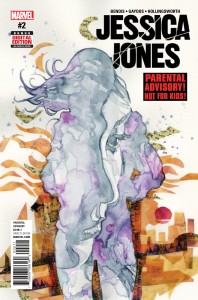 Jessica Jones #2 — Writer: Brian Michael Bendis; Art: Michael Gaydos; Colors: Matt Hollingsworth
Jessica Jones #2 — Writer: Brian Michael Bendis; Art: Michael Gaydos; Colors: Matt Hollingsworth
Infamous Iron Man #2 — Writer: Brian Michael Bendis; Art: Alex Maleev; Colors: Matt Hollingsworth
Spider-Man #9 — Writer: Brian Michael Bendis; Art: Nico Leon; Colors: Marte Gracia
Three books out this week written by Bendis, who’s been one of the prime architects of the Marvel world for a number of years now. Jessica Jones is the best, because it’s closest to the noirish detective style (flavored with super-powers) that was his entry into comics, and because it focuses so closely on his fascinating, damaged-but-noble main character, now jolted out of 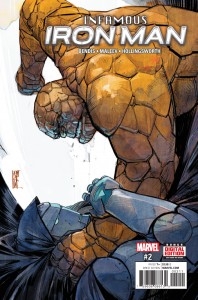 her happy-ending marriage to Luke Cage and freshly out of prison, broke, hiding her daughter from her husband and his friends (who don’t even know if the girl’s alive), and taking on private-investigator clients again; mix in an obscure super-villain or two, and Gaydos’s emotion-rich, shadowy, pitch-perfect art, and this is top-tier work. Infamous Iron Man is more kind of Bendis-average, with a high-concept hook (Doctor Doom, now unscarred and no longer a bad guy — probably — takes up the mantle, and armor, of the now-absent Tony Stark), a lot of conversation, some interesting characterization, and a leisurely, deconstructed pace. Maleev, like Gaydos, has a dark-tinged, emotionally-heavy style that plays to Bendis’s strengths, and although this is a quick read, it’s an addictive one; the fight that’s featured on the cover merely begins this issue, and you won’t be able to finish the last page
her happy-ending marriage to Luke Cage and freshly out of prison, broke, hiding her daughter from her husband and his friends (who don’t even know if the girl’s alive), and taking on private-investigator clients again; mix in an obscure super-villain or two, and Gaydos’s emotion-rich, shadowy, pitch-perfect art, and this is top-tier work. Infamous Iron Man is more kind of Bendis-average, with a high-concept hook (Doctor Doom, now unscarred and no longer a bad guy — probably — takes up the mantle, and armor, of the now-absent Tony Stark), a lot of conversation, some interesting characterization, and a leisurely, deconstructed pace. Maleev, like Gaydos, has a dark-tinged, emotionally-heavy style that plays to Bendis’s strengths, and although this is a quick read, it’s an addictive one; the fight that’s featured on the cover merely begins this issue, and you won’t be able to finish the last page 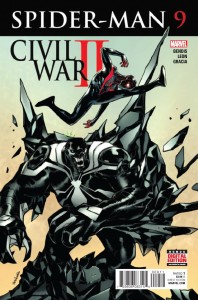 without immediately wondering what’s going to happen next. Spider-Man is the most regular-super-hero-y of the lot, since it’s tied directly into Civil War II; in this issue, we don’t actually see Miles at all (except second-hand), since the story’s about his various friends and family, super and otherwise, trying to track him down after the events in that mini-series. In fact, the last page here is pretty much the same as the final page of the most-recent Civil War II, so Miles’s situation hasn’t changed — but we now know a lot more about all the other people in his life, and sometimes that kind of fill-in-the-supporting-cast breather is exactly what’s needed to insure a book’s long-term health.
without immediately wondering what’s going to happen next. Spider-Man is the most regular-super-hero-y of the lot, since it’s tied directly into Civil War II; in this issue, we don’t actually see Miles at all (except second-hand), since the story’s about his various friends and family, super and otherwise, trying to track him down after the events in that mini-series. In fact, the last page here is pretty much the same as the final page of the most-recent Civil War II, so Miles’s situation hasn’t changed — but we now know a lot more about all the other people in his life, and sometimes that kind of fill-in-the-supporting-cast breather is exactly what’s needed to insure a book’s long-term health.
 Amazing Spider-Man #21 — Writers: Dan Slott and Christos Gage; Pencils: Giuseppe Camuncoli; Inks: Cam Smith and Roberto Poggi; Colors: Jason Keith
Amazing Spider-Man #21 — Writers: Dan Slott and Christos Gage; Pencils: Giuseppe Camuncoli; Inks: Cam Smith and Roberto Poggi; Colors: Jason Keith
The Unbeatable Squirrel Girl #14 — Writer: Ryan North; Art: Erica Henderson; Colors: Rico Renzi
Hellcat #12 — Writer: Kate Leth; Art: Brittney L. Williams; Colors: Rachelle Rosenberg
Amazing Spider-Man offers another chapter of the “Clone Conspiracy” arc, and as if having almost everyone who’s ever died in this comic in the last fifty  years return alive and (not quite) like new isn’t enough, now Slott and Gage introduce elements from the recent Spider-Verse story too, especially a version of Kaine/Scarlet Spider who has some disturbing revelations about just how critical the events here have been to the Marvel Earth in other alternate realities; lots of widescreen action and interaction, and the high stakes involved, keep the energy and interest levels high. Squirrel Girl finishes up its current story, guest-starring Ant Man, with its typical humor, clever action and you-don’t-always-have-to-punch-somebody-to-solve-a-problem theme. North and Henderson continue to provide
years return alive and (not quite) like new isn’t enough, now Slott and Gage introduce elements from the recent Spider-Verse story too, especially a version of Kaine/Scarlet Spider who has some disturbing revelations about just how critical the events here have been to the Marvel Earth in other alternate realities; lots of widescreen action and interaction, and the high stakes involved, keep the energy and interest levels high. Squirrel Girl finishes up its current story, guest-starring Ant Man, with its typical humor, clever action and you-don’t-always-have-to-punch-somebody-to-solve-a-problem theme. North and Henderson continue to provide 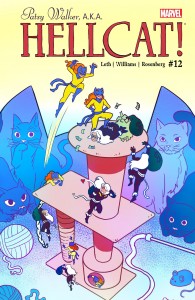 the most unique mix of art, story, satire and brains since the original Gerber/Colan Howard the Duck; here’s hoping they’ll be able to continue it for years to come. Hellcat isn’t quite at their level, but it, too, combines Brittney Williams’s cute, cartoony-manga style with Rachelle Rosenberg’s bright, perfect colors and Kate Leth’s mix of light-hearted adventure and continuity-rich drama into a hard-to-resist feline fracas involving Patsy vs. the Black Cat and her gang; if you haven’t tried it yet, this middle-of-the-story issue is a good sampler of the comic at its good-hearted, charming best.
the most unique mix of art, story, satire and brains since the original Gerber/Colan Howard the Duck; here’s hoping they’ll be able to continue it for years to come. Hellcat isn’t quite at their level, but it, too, combines Brittney Williams’s cute, cartoony-manga style with Rachelle Rosenberg’s bright, perfect colors and Kate Leth’s mix of light-hearted adventure and continuity-rich drama into a hard-to-resist feline fracas involving Patsy vs. the Black Cat and her gang; if you haven’t tried it yet, this middle-of-the-story issue is a good sampler of the comic at its good-hearted, charming best.
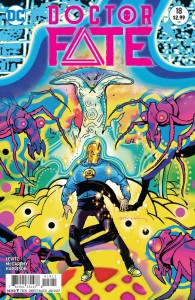 Doctor Fate #18 — Writer: Paul Levitz; Art: Brendan McCarthy; Colors: Mark Harrison and Brendan McCarthy
Doctor Fate #18 — Writer: Paul Levitz; Art: Brendan McCarthy; Colors: Mark Harrison and Brendan McCarthy
Cave Carson Has a Cybernetic Eye #2 — Writers: Gerard Way and Jon Rivera; Art: Michael Avon Oeming; Colors: Nick Filardi
Superman #11 — Writer: Peter J. Tomasi; Co-story/Pencils: Patrick Gleason; Inks: Mick Gray, Mark Morales and Christian Alamy; Colors: John Kalisz
Batman #11 — Writer: Tom King; Pencils: Mikel 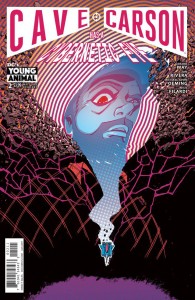 Janin; Inks: Mikel Janin and Hugo Petrus; Colors: June Chung
Janin; Inks: Mikel Janin and Hugo Petrus; Colors: June Chung
Doctor Fate, of all books, gets top DC billing this week because the art’s by Brendan McCarthy, the British artist whose psychedelic, brightly-colored style has graced books like 2000 AD, Paradax, and a bunch of stuff with fellow-Brit Peter Milligan; Marvel fans probably know him best for the Spider-Man/Doctor Strange mini-series, Fever. Doctor Fate, like Strange, offers a mystical, surreal background that’s precisely suited to his talents, and so the guest-shot art here — anchored by regular Fate writer Paul Levitz’s steady plotting hand — is a welcome dose of fun. Cave Carson Has a Cybernetic Eye continues to benefit from its artist, too —  Michael Avon Oeming — whose angular, minimalist style is able to handle action with dynamic grace: a good thing, because this book, combining underground societies, conspiracies, a burnt-out hero, the titular eye (which we see installed this issue, in gory detail), and guest-star vigilante Mad Dog (perhaps the most obscure DC hero to ever have, briefly, his own comic) just rockets along, dispensing Easter eggs for longtime readers in between its assassination attempts, chase scenes, and exuberant plotting. Superman manages to up the excitement level, too, and from an unexpected source — Clark’s son Jon, who’s gotten entangled with Bruce “Batman” Wayne’s son Damian; the two fathers force the kids to work together to solve a number of puzzles and tasks, so that they learn to get along and operate as a team. That doesn’t go
Michael Avon Oeming — whose angular, minimalist style is able to handle action with dynamic grace: a good thing, because this book, combining underground societies, conspiracies, a burnt-out hero, the titular eye (which we see installed this issue, in gory detail), and guest-star vigilante Mad Dog (perhaps the most obscure DC hero to ever have, briefly, his own comic) just rockets along, dispensing Easter eggs for longtime readers in between its assassination attempts, chase scenes, and exuberant plotting. Superman manages to up the excitement level, too, and from an unexpected source — Clark’s son Jon, who’s gotten entangled with Bruce “Batman” Wayne’s son Damian; the two fathers force the kids to work together to solve a number of puzzles and tasks, so that they learn to get along and operate as a team. That doesn’t go 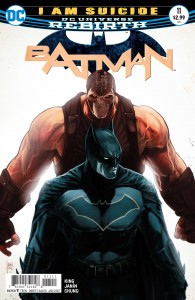 quite as well as hoped, kids being kids, but it’s fun to watch, and as a run-up to the Odd Couple-ish Super Sons comic next year, it’s a hopeful sign. Batman, meanwhile, isn’t hopeful at all, as the Caped Crusader has assembled a Suicide Squad under his command (Catwoman, Punch and Jewelee, and Bronze Tiger, among others) to take on Bane and his island fortress. As with any Mission:Impossible style plan, things go astray, with double and triple crosses and a last-page cliffhanger; King’s proven himself a clever, twisty plotter over the last year, so it’ll be interesting to see how this will get resolved, and who will get out of it alive.
quite as well as hoped, kids being kids, but it’s fun to watch, and as a run-up to the Odd Couple-ish Super Sons comic next year, it’s a hopeful sign. Batman, meanwhile, isn’t hopeful at all, as the Caped Crusader has assembled a Suicide Squad under his command (Catwoman, Punch and Jewelee, and Bronze Tiger, among others) to take on Bane and his island fortress. As with any Mission:Impossible style plan, things go astray, with double and triple crosses and a last-page cliffhanger; King’s proven himself a clever, twisty plotter over the last year, so it’ll be interesting to see how this will get resolved, and who will get out of it alive.
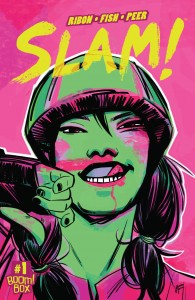 Slam! #1 — Writer: Pamela Ribon; Art: Veronica Fish; Colors: Brittany Peer
Slam! #1 — Writer: Pamela Ribon; Art: Veronica Fish; Colors: Brittany Peer
Ether #1 — Writer: Matt Kindt; Art/Colors: David Rubin
Grand Passion #1(of 5) — Writer: James Robinson; Art: Tom Feister; Colors: David Curiel
A trio of indy first issues: Slam! is about roller-derby babes, with an all-female creative team making the two rookies who are the main characters both 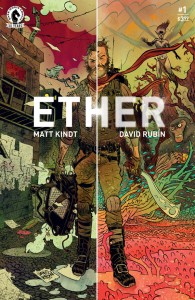 sympathetic and relatable, and Veronica Fish (last seen on Archie) giving the art a nice mix of realism (providing emotional heft) and just enough cartoony exaggeration to energize it; it’s surprisingly good, given its sometimes-mocked subject, and a valentine to the sport. Ether is about a scientist who discovers, and travels to, a magic-based fairyland; his stubborn rationalism gives him a perspective the supernatural inhabitants lack, and lets him solve their mysteries and problems, much like Adam Strange on the planet Rann — but his
sympathetic and relatable, and Veronica Fish (last seen on Archie) giving the art a nice mix of realism (providing emotional heft) and just enough cartoony exaggeration to energize it; it’s surprisingly good, given its sometimes-mocked subject, and a valentine to the sport. Ether is about a scientist who discovers, and travels to, a magic-based fairyland; his stubborn rationalism gives him a perspective the supernatural inhabitants lack, and lets him solve their mysteries and problems, much like Adam Strange on the planet Rann — but his 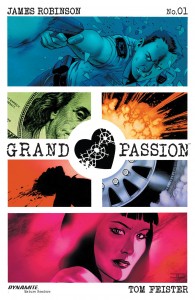 adventures come at a cost to his once-stable Earth life. It’s written by Matt Kindt, so you know it’s well-thought-out, and surprising in all the right ways. Grand Passion, by James Robinson, is about a Bonnie-and-Clyde couple and what happens when the Bonnie half meets a cop, and they instantly fall in love — right before they kill each others’ partners. It’s got a couple of annoying Robinsonian narrative tics, and its being a mini-series indicates that the relationship won’t end well, but the doomed-lovers setup looks intriguing enough to goose along the other four issues and make the story work.
adventures come at a cost to his once-stable Earth life. It’s written by Matt Kindt, so you know it’s well-thought-out, and surprising in all the right ways. Grand Passion, by James Robinson, is about a Bonnie-and-Clyde couple and what happens when the Bonnie half meets a cop, and they instantly fall in love — right before they kill each others’ partners. It’s got a couple of annoying Robinsonian narrative tics, and its being a mini-series indicates that the relationship won’t end well, but the doomed-lovers setup looks intriguing enough to goose along the other four issues and make the story work.
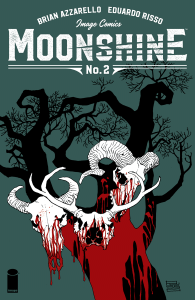 Moonshine #2 — Writer: Brian Azzarello; Art/Colors: Eduardo Risso
Moonshine #2 — Writer: Brian Azzarello; Art/Colors: Eduardo Risso
Kill or Be Killed #4 — Writer: Ed Brubaker; Art: Sean Phillips; Colors: Elizabeth Breitweiser
Lady Killer #3 — Writer/Artist: Joelle Jones; Colors: Michelle Madsen
Archie #14 — Writer: Mark Waid; Art: Joe Eisma; Colors: Andre Szymanowicz
Cinema Purgatorio #7 — Creators: Various
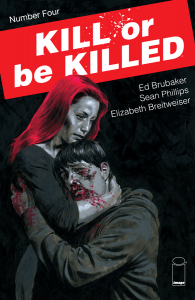 Of the other indy comics, Moonshine is the second issue of the new Brian Azzarello/Eduardo Risso book; both of those creators have a fascination with the grotesque, and with film noir (see 100 Bullets), and this tale of a Prohibition-era New York gangster in the Appalachians searching for a legendary manufacturer of the title alcohol provides plenty of both. Azzarello often has a problem with endings, but the journey’s always worthwhile, and the Argentinian Risso’s depictions of the hardscrabble, tough-minded country folk and the dapper gangster are wonderful to look at — even before the supernatural element shows up and really gives him a chance to let loose. Kill or Be Killed mines a similar hard-boiled/horror
Of the other indy comics, Moonshine is the second issue of the new Brian Azzarello/Eduardo Risso book; both of those creators have a fascination with the grotesque, and with film noir (see 100 Bullets), and this tale of a Prohibition-era New York gangster in the Appalachians searching for a legendary manufacturer of the title alcohol provides plenty of both. Azzarello often has a problem with endings, but the journey’s always worthwhile, and the Argentinian Risso’s depictions of the hardscrabble, tough-minded country folk and the dapper gangster are wonderful to look at — even before the supernatural element shows up and really gives him a chance to let loose. Kill or Be Killed mines a similar hard-boiled/horror  combo, with Brubaker and Phillips bringing a collaboration just as long-standing, and just as skilled, to their tale of an ordinary shlub who gets entangled with a demon and faces a simple task: kill one person, of his choosing, every month, or go to hell himself; watching him work out how to do it and keep his moral code, and soul, intact is what drives the book, and keeps bringing us back. Joelle Jones, on Lady Killer, doesn’t have to worry about collaborators — she’s both artist and writer of this book, which, as the title informs us, is about yet another murderer, this one a prim early-’60s housewife who, on the side, is a contract killer. It’s obvious that Jones has studied fashions and ad layouts of the era, to good effect, and
combo, with Brubaker and Phillips bringing a collaboration just as long-standing, and just as skilled, to their tale of an ordinary shlub who gets entangled with a demon and faces a simple task: kill one person, of his choosing, every month, or go to hell himself; watching him work out how to do it and keep his moral code, and soul, intact is what drives the book, and keeps bringing us back. Joelle Jones, on Lady Killer, doesn’t have to worry about collaborators — she’s both artist and writer of this book, which, as the title informs us, is about yet another murderer, this one a prim early-’60s housewife who, on the side, is a contract killer. It’s obvious that Jones has studied fashions and ad layouts of the era, to good effect, and 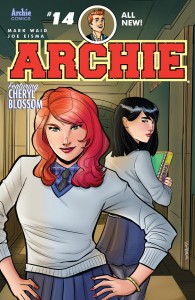 she has a solid design sense that elevates her already-elegant art even more — just look at that cover, with its pop-art circles and Hitchcockian pose — increasing the odds that she’s going to be a major creator for years to come. Archie continues its Mark Waid reboot, as Veronica Lodge, exiled to a Swiss boarding school, meets up with, and has a queen-bee dominance fight with, Cheryl Blossom, while back in Riverdale Archie tries to get over her, and keeps ignoring pal Jughead’s “hakuna matata” advice — until he decides to take it, leading to even more complications, I’ve read a ton of classic Archie comics, from the ’50s ’til now, and this streamlining and modernizing of the perpetually-teen redhead has been a welcome, and successful, effort to drag him into the 21st century. That leaves Cinema Purgatorio, whose first story is always a
she has a solid design sense that elevates her already-elegant art even more — just look at that cover, with its pop-art circles and Hitchcockian pose — increasing the odds that she’s going to be a major creator for years to come. Archie continues its Mark Waid reboot, as Veronica Lodge, exiled to a Swiss boarding school, meets up with, and has a queen-bee dominance fight with, Cheryl Blossom, while back in Riverdale Archie tries to get over her, and keeps ignoring pal Jughead’s “hakuna matata” advice — until he decides to take it, leading to even more complications, I’ve read a ton of classic Archie comics, from the ’50s ’til now, and this streamlining and modernizing of the perpetually-teen redhead has been a welcome, and successful, effort to drag him into the 21st century. That leaves Cinema Purgatorio, whose first story is always a 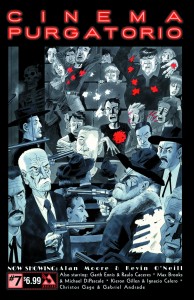 vaguely-ominous, off-kilter film by anthology editor Alan Moore and longtime partner Kevin O’Neill, this one about the clash between the disappointingly-banal true history of the Gunfight at the OK Corral and its cinema-stoked legend. Mix in the other serials by writers like Garth Ennis, Max Brooks, Kieron Gillen and Christos Gage, and the moody black-and-white art by Raulo Caceres, Michael DiPascale, Nahuel Lopez and Gabriel Andrade, and this is one of three successful anthologies on the stands right now (Island and Dark Horse Presents are the others, and, despite different styles and target audiences, all three survive by consistently delivering entertaining, solidly-told comics).
vaguely-ominous, off-kilter film by anthology editor Alan Moore and longtime partner Kevin O’Neill, this one about the clash between the disappointingly-banal true history of the Gunfight at the OK Corral and its cinema-stoked legend. Mix in the other serials by writers like Garth Ennis, Max Brooks, Kieron Gillen and Christos Gage, and the moody black-and-white art by Raulo Caceres, Michael DiPascale, Nahuel Lopez and Gabriel Andrade, and this is one of three successful anthologies on the stands right now (Island and Dark Horse Presents are the others, and, despite different styles and target audiences, all three survive by consistently delivering entertaining, solidly-told comics).



